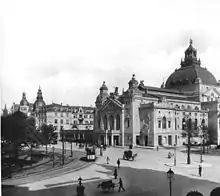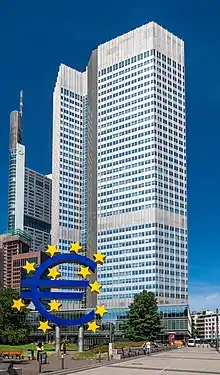Willy-Brandt-Platz
The Willy-Brandt-Platz is a central square in Frankfurt am Main, Hesse, Germany. Its name was Theaterplatz (Theatre square) until 1992, when it was named after Willy Brandt, the former chancellor. It is located between the Main Station and the Altstadt, at the Frankfurter Anlagenring, and is part of the so-called Bankenviertel. Major buildings are the Städtisches Opern- und Schauspielhaus, the municipal theatre that opened in 1963,[1][2] and the Eurotower skyscraper. Below the square are the U-Bahnhof Willy-Brandt-Platz and the Theatertunnel street tunnel.
 View of the square from the Main Tower | |
| Former name(s) |
|
|---|---|
| Namesake | Willy Brandt |
| Type | Square |
| Location | Frankfurt, Hesse, Germany |
| Coordinates | 50°6′33″N 8°40′26″E |
History

The square was the location of a city gate to the West, the Neues Galgentor. The fortifications (Frankfurter Stadtbefestigung) were demolished in 1809. The former fortifications were replaced by a park called Wallanlagen. When the theatre (Schauspielhaus) was completed in 1902, the square was named Theaterplatz. The square was severely damaged during air raids in World War II, in which the Schauspielhaus was destroyed during an air raid in 1944. It was renamed again in 1992 to honour Willy Brandt.[3][2]
Description
The square is open for pedestrians, the tram, cars, and the U-Bahn below it. Cars were preferred, which led to less flexibility for other parties. The building of the Theatertunnel in 1974 helped to reduce car traffic significantly.[1]
From 2004, when an underground parking lot below the square was completed, it was remodelled to ensure accessibility for handicapped people of public institutions. At the same time, a new lighting system was installed.[4]

In the Gallusanlage, north of the square, one of two copies of the monumental sculpture Euro-Skulptur by Ottmar Hörl dominates the park.[5][lower-alpha 1] The 14 m (46 ft)-high, 50-ton sculpture, consisting of a blue euro sign surrounded by twelve yellow stars representing the first member nations of the European Union, is illuminated at night by 330 neon light strips. The acrylic glass sculpture was installed in 2001.[7] A sculptured fountain, Märchenbrunnen (Fairy-tale Fountain), created by Friedrich Christoph Hausmann in Jugendstil, is placed next to the opera house.[8]
U-Bahnhof
At the U-Bahn station Willy-Brandt-Platz, lines of the Strecke A (U1, U2, U3 und U8) and Strecke B (U4 and U5) connect.[9]
Notes
- The second sculpture, installed at Frankfurt Airport also in 2001, was dismantled in 2012.[6]
References
- "Chronik der Innenstadt". frankfurt.de (in German). Frankfurt. Retrieved 13 September 2019.
- Hierholzer, Michael (29 May 2019). "Städtische Bühnen Frankfurt : Theater bleibt am Willy-Brandt-Platz /". FAZ (in German). Retrieved 13 September 2019.
- Göpfert, Hans-Jürgen (21 November 2016). "Blicke in den Schilderwald / Der doppelte Her(r)mann". Frankfurter Rundschau (in German). Retrieved 13 September 2019.
- "Willy-Brandt-PlatzFrankfurt-Innenstadt". stadtplanungsamt-frankfurt.de (in German). pp. 31–35. Retrieved 13 September 2019.
- "Chronik der Innenstadt". kunst-im-oeffentlichen-raum-frankfurt.de (in German). Frankfurt. Retrieved 13 September 2019.
- Nielsen, Nikolaj (21 August 2019). "Euro sign sculptures in Frankfurt face uncertain future". EUobserver. Retrieved 25 September 2019.
- Agence France-Presse (7 July 2015). "Workers dismantle Frankfurt Euro sculpture". The Local. Retrieved 25 September 2019.
- "Untermainanlage". frankfurt.de (in German). Retrieved 13 September 2019.
- Willy-Brandt-Platz station – Frankfurt U-Bahn map subway.umka.org
External links
- U-Bahn-Station "Willy-Brandt-Platz": VGF und Stadtplanungsamt gestalten Eingang vor dem Schauspielhaus neu vgf-ffm.de, 28 December 2009
- U-Bahn-Zugang am Willy-Brandt-Platz in Frankfurt baunetzwissen.de